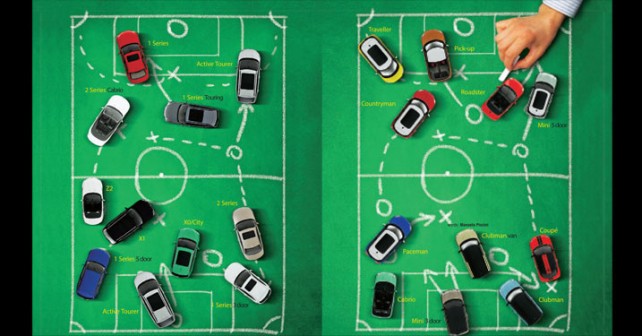
Munich changes the gameplan, and sends onto the pitch the first front-wheel drive BMW. It’ll start in 2014 with the Active Tourer. After that, there’ll be at least ten more!
Here are two teams – BMW and Mini – each one playing in a different league. The title they vie over, however, is the same – to sell just under a million front-wheel drive cars. There’s also only one trainer – a group that, in 2012, had a turnover of 76.8 billion Euros (including Rolls-Royce) and delivered 1.85 million vehicles. The two will share junior camps, where they will nurture new budding stars – this being the Ukl1 platform, which every team will use despite wearing different uniforms (bodywork).
Eleven on each side, all of them destined to hit the pitch starting next Fall – until the end of 2020. The honour of the kick-off will be given to the third generation Mini. The date is already fixed – 18th of November. In June 2014, it’ll be the turn of the of the double helix team to present the definitive version of its Active Tourer – the first BMW with front-wheel drive, based on the concept Outdoor unveiled in mid-July and shown recently at the Frankfurt Motor Show.
Variable Formation
The change in tactics is truly momentous (though this has been written too often). Dictated by the need to reduce costs, and seeing that Mini is profitable, but not sufficiently enough, with its 300,000 cars per year, in order to write off the evermore exorbitant investments in R&D. From this comes the idea to migrate the front-wheel drive mechanical platform even on to the future ranges of the parent company – namely the 1 and 2 Series whose buyers the data shows take almost no interest in the fundamental technical characteristics.
Thus, with the taboo of the perennial rear-wheel-drive ethos having been broken, the BMW trainer is left with no other choice than to teach this new attacking strategy to as many players as possible. The Uk11, moreover, lends itself well to this strategy since it can switch between three pitch formations. This translates into lengths from 380 to 440cm, and in at least two different height positions for the driving position, along with the capability of hosting three and four cylinder engines, as well as hybrids. In fact, from now to the fateful year 2020, which the elite automakers have called the year of reckoning, there will be rookies aplenty on the pitch.
We start with Mini. Of the model that will inaugurate the third generation, much has been said and written about, perhaps too much. There is little doubt that the three-door model will occupy the attacking forward position, but the assists given by the rest of the team will be evermore valuable – all of those that are already in play, from the Coupé to the Cabrio, from the Clubman to the Roadster, from the Paceman to the Countryman, with the third generation of the latter seemingly destined to assume more SUV-type mutations and maybe even split off into the Traveller – finding inspiration from the ranges of the 60’s and 70’s. And more probable than a 5-door model is an MPV sub-range. But, knowing the inventiveness of the brand, why not a pick-up? BMW, meanwhile, will also have a lot of work to do. From the Active Tourer minivan, there will be the gradual addition of the new 1 Series generation (3 and 5 door, GT, Estate, Sedan), the future X1 and X2 SUVs, and the 2 Series Cabrio of 2020 and the Z2 roadster.
Two teams. To referee the game, whistle in its hand, will be many market forces.
Similar but different
A glimpse into the future
Anders Warming (on the left), together with Oliver Sieghart – interiors – and Annette Baumeister – colours and materials – have no doubt that the Mini of the future will continue to draw inspiration from the forms of the past (read 1959), but it will know how to adapt these suggestions into the modern age. What’s striking about the Mini vision is the use of the innovative composites, which underlines certain traits of the bodywork and connects the car body to the glass surfaces.
© Riproduzione riservata
























Write your Comment